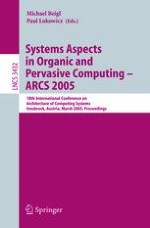2005 | Buch
Systems Aspects in Organic and Pervasive Computing - ARCS 2005
18th International Conference on Architecture of Computing Systems, Innsbruck, Austria, March 14-17, 2005. Proceedings
herausgegeben von: Michael Beigl, Paul Lukowicz
Verlag: Springer Berlin Heidelberg
Buchreihe : Lecture Notes in Computer Science
